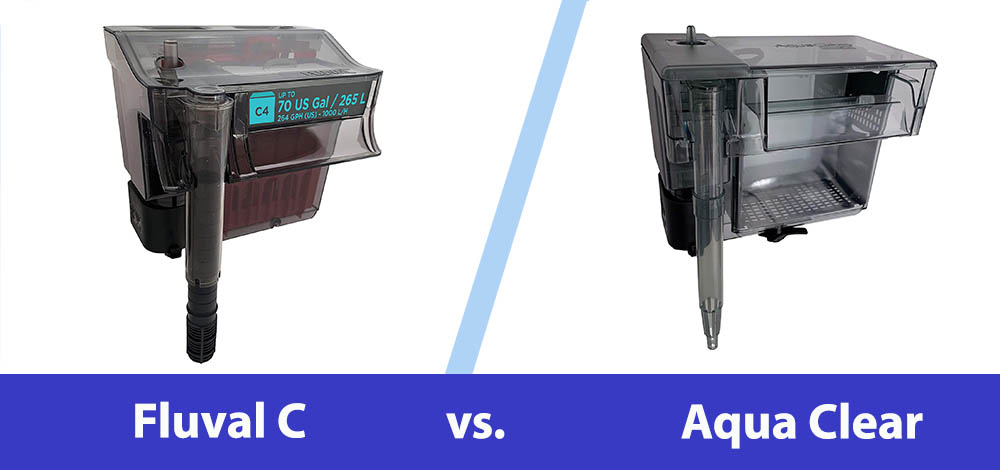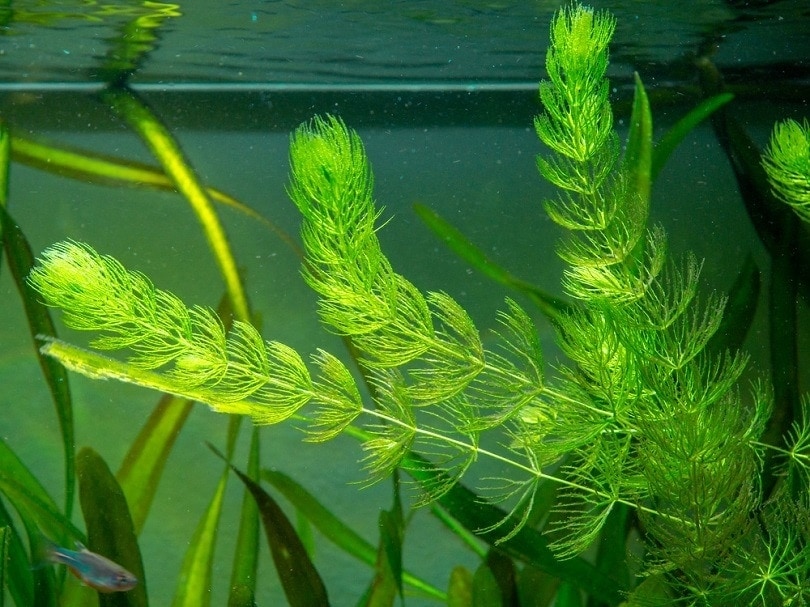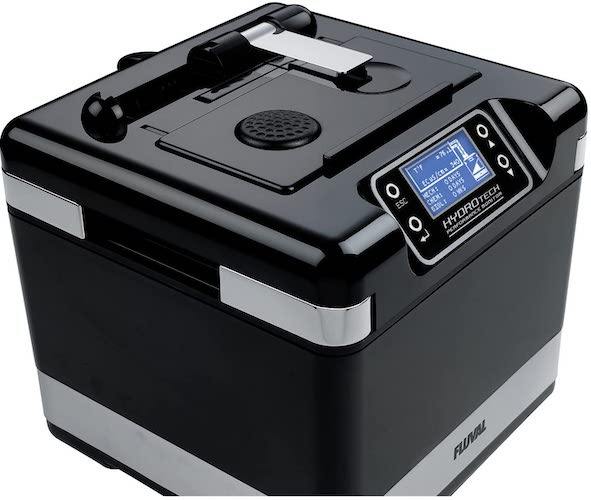How To Take Care of A Piranha Fish: Water Conditions & Tank Setups

Updated on
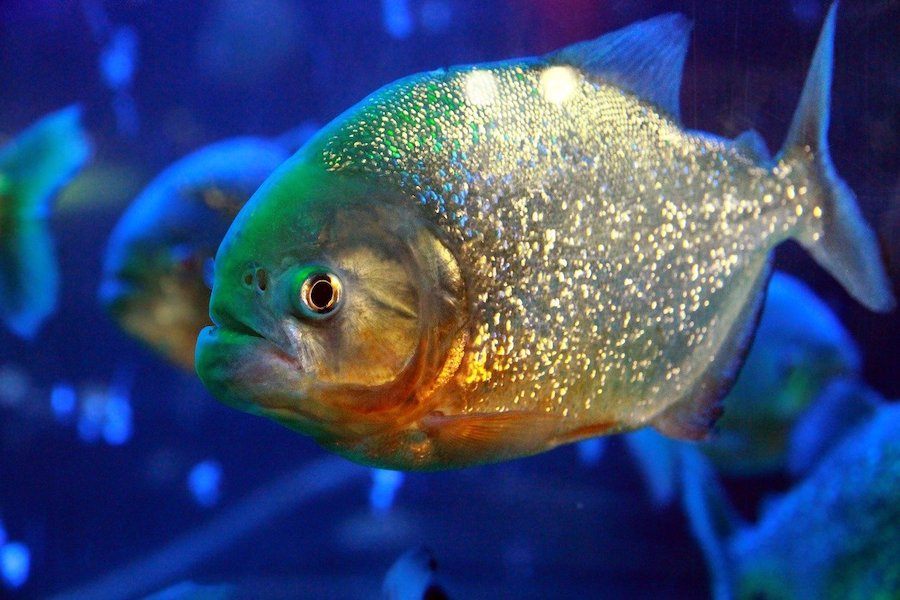
Piranhas have a nasty reputation for being mean fish that kill everything in their paths. Well, yes, they are not the most docile fish out there and they certainly love hunting prey when the time calls for it. However, many people have begun keeping these neat fish in home aquariums.
It may sound like a bit of a challenge, but it is really no big deal. How to take care of a piranha is what we are here to discuss today. We’re going to cover everything from A to Z in terms of piranha care, so let’s get right to it.
Piranha Basics
Piranhas are some really cool fish no doubt. Yes, they have a reputation for being aggressive and ferocious, but this is really only when they are very hungry. They can actually be somewhat peaceful in a home aquarium, especially if you house them with their own kind.
This is a tropical freshwater fish with origins in both Africa and South America. Most piranhas that are in home aquariums originated in South America.
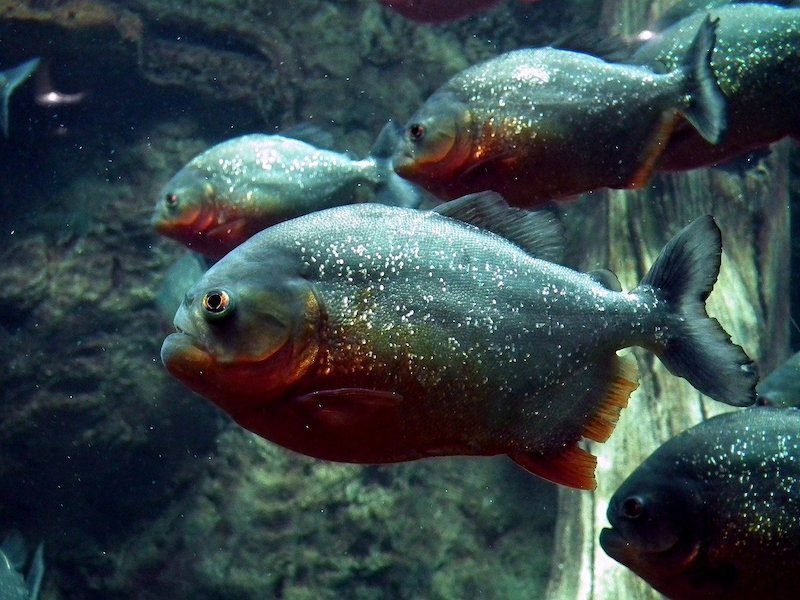
How Big Do Piranhas Get?
Small piranhas can grow to around 10 centimeters in length, while the bigger ones can reach up to 30 centimeters, or about 1 foot in length. For this article, we are talking about the smaller ones.
The larger varieties of piranhas can live to around 15 years, with smaller ones maxing out at about 4 to 5 years of age. That being said, the better you care for them, the longer they will live. They are not the most beautiful or colorful fish around, but many love them nonetheless.
Piranha Fish Tank Setup
The first thing you need to do to effectively take care of your Piranha is to get the right tank. Right now we are talking about the size of the tank specifically.
Piranha Tank Size
Piranhas do need a fair amount of space as they are not the smallest fish out there. They are also very agile and love to swim around, so they like their open swimming space quite a bit.
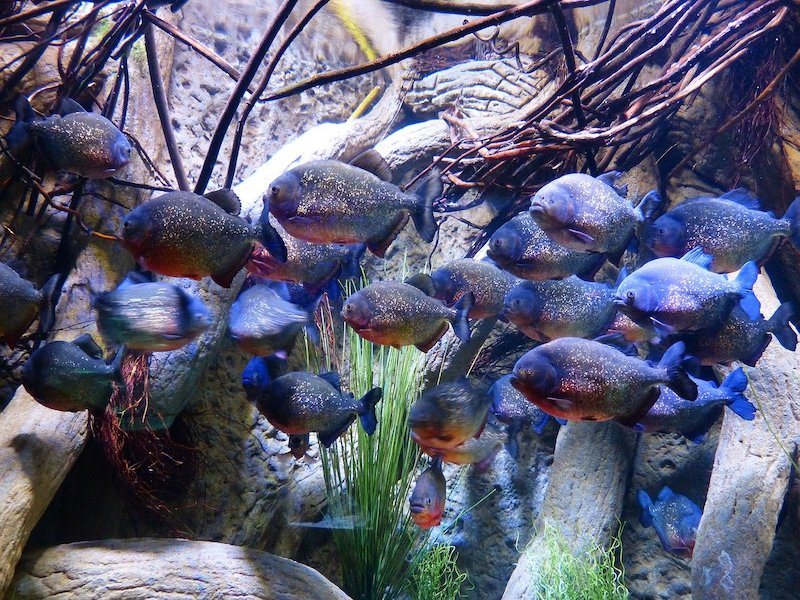
Ideal Tank Size?
As a general rule, a single Piranha should have at least a 20-gallon tank, which is more or less the absolute minimum. That being said, these are schooling fish of sorts, which means that they don’t like to be alone.
We would recommend getting at least 4 of these fish to ensure that they are happy and feel as though they are part of a group.
What We Think On Tank Size
Most would say that a 60-gallon tank is enough for four piranhas, but we prefer going with something larger, at least an 80-gallon tank. These fish do really like their space and are not built for small and tight environments.
On a side note, we would get a screen lid for your piranha tank. These bad boys like to jump, especially when hungry. They have been known to make their way out of their tanks on many occasions.
Placing The Piranha Tank
When it comes to placing the piranha tank in the right spot, there are really only a few things to keep in mind. First and foremost, they can get stressed out, plus they can be quite aggressive at times.
So, your best bet is to keep them away from really high-traffic areas. At the same time, you want to keep them away from external heat sources and direct sunlight because this can cause algae to grow. Other than that, you can place the Piranha tank pretty much wherever you see fit.
Setting Up The Tank – Plants, Substrate, & More
Substrate
You should aim for some smooth rocks or smooth aquarium gravel for your piranha substrate. You don’t want to use sand because it is hard to clean, plus piranhas are not big on burrowing anyway. You also don’t want to use aquarium dirt because it is unnecessary for these fish, plus they will probably make a mess of it too.
Some rocks or gravel made of granite, basalt, gneiss, quartz, or slate are fine. You should avoid limestone, dolomite, and marble. Only cover about ½ to 1 inch of the bottom with this kind of substrate. Any more than that is not necessary. Piranhas don’t really care about the substrate.
Plants
Another thing that you will want to do is add a lot of plants to the tank, especially if you have lots of piranhas together. They can get stressed out and they like to hide. They also live in places where there are lots of plants, especially on the bottom.
A lot of submerged plants will make the piranhas happy. There are lots of plants you can go with, especially because piranhas won’t eat most of them. As long as you have a lot of bushy and big leafy plants, your piranhas will be happy.
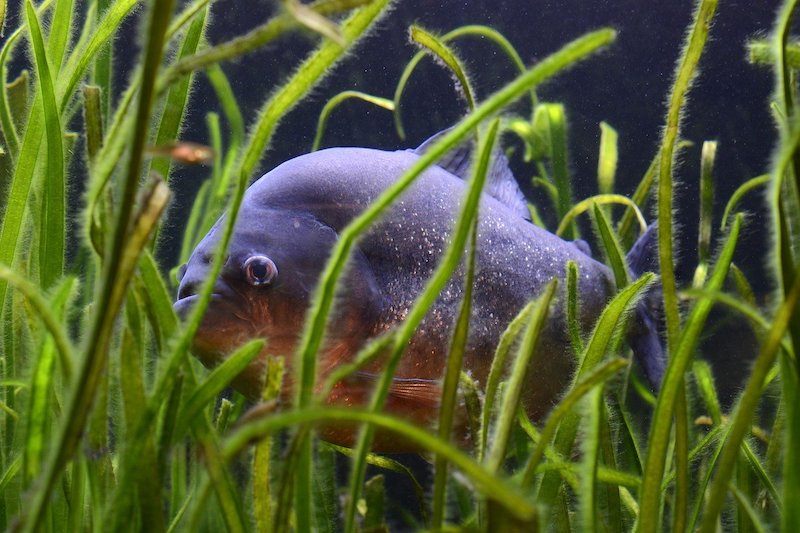
Don’t Forget Decorations
Furthermore, adding a lot of rocks, caves, decorations, and things like pipes that they can swim through and hide in are also all good ideas. As we said, these fish like hiding places and they like getting some space apart from other tank members.
You can also add some driftwood into the mix. However, be sure to keep the center of the tank, the middle of the column, and the top clear of plants and objects. Piranhas do like to have a lot of room for swimming around.
Piranha Water Conditions
Like all other fish in your home aquarium, piranhas need special water conditions too. They are fairly hardy and resilient fish, so you don’t have to worry too much. However, for optimal morale and health, you should stick to the following tips and parameters fairly closely.
After all, these are your pets and they can’t take care of themselves, so you need to make sure that you provide them with the best possible habitat.
Ideal Temperature For Piranha Fish
First and foremost, these are tropical freshwater fish. This means that the water cannot have any salinity, plus it needs to be fairly warm. In other words, the water for a piranha tank needs to be between 21 and 25 degrees Celsius or 75 to 80 degrees Fahrenheit.
This means that you will most likely need a water heater, plus an aquarium thermometer. You need to make sure that the water temperature does not go below or above the aforementioned temperature range.

Ideal pH Levels
Next, you do also need to have the acidity or pH level within a certain range too. While they do require this pH range to be kept constant, the range is actually fairly wide. Ok, so they are resilient and can handle changing pH levels, just as long as the changes don’t happen too fast and don’t go below or above the recommended level.
To keep a piranha happy and healthy, the pH should be between 5.5 and 8.0. As you can see, they do just fine in both fairly acidic and basic water.
Cleaning The Tank
Piranhas are fairly messy fish and voracious eaters that produce a lot of waste, especially if you have numerous fish in the tank. You will need to clean the tank fairly often, performing about a 10% water change per week.
Performing regular water changes will ensure that there is not a big buildup of bad bacteria, parasites, or other unwanted toxins in the tank. You also want to make sure that you clean the plants, rocks, substrate, and decorations at least once every 2 weeks. Next, you need a good filtration unit for your Piranha tank too. This is essential because these fish are so messy and produce a lot of waste. While they are very hardy, they do like their water to be clean, just like any other fish out there.
Getting a good 3 stage filtration unit that incorporates mechanical, biological, and chemical filtration is a must-have. For piranha tanks, the filter you get should be able to process at least 5 times the total water volume of the tank per hour.
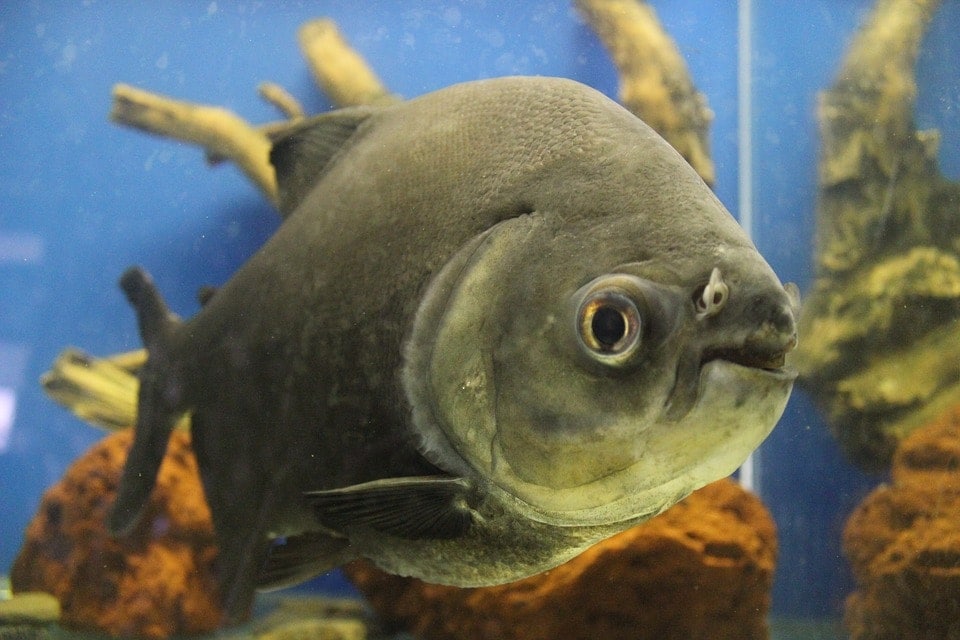
Lighting For Piranha
Finally, you won’t have to do much in terms of lighting. Piranhas in the wild tend to live in dark and murky waters, so their eyes have adapted to darkness fairly well. A simple aquarium light will do just fine here.
 Piranha Feeding
Piranha Feeding
Thankfully, piranhas are easy to feed no doubt. Opposed to popular belief, these fish are not just carnivores. While they are known for eating all kinds of fish and other animals too, they do also enjoy other foods.
How Often Should I Feed My Piranha Fish?
They are big-time omnivores with nearly insatiable appetites. You should feed your piranhas no more than once per day, and no more food than they can eat in 2 minutes. They should receive a fairly varied diet to meet their nutritional needs.
What Should I Feed Piranha?
Many people feed piranhas small goldfish and other feeder fish, which is just fine. You can also go with other foods like live or freeze-dried daphnia, shrimp, blood worms, tubifex worms, rain worms, snakeskin, crab, and other such things.
Some people will feed them chunks of chicken, beef, and pork, but we would recommend avoiding this due to disease. Plus, something about fish eating land animals is just kind of odd as far as we are concerned.
A General Tip On Feeding
A good idea is to substitute some of their meats with veggies. They will love some potatoes, zucchini, spinach, and other leafy greens. You should avoid feeding these fish pellets or flake foods. Also, if you can manage, freeze-dried foods are better than live ones because the freeze-drying process removes parasites and bacteria from the food.
That being said, it can be pretty cool to watch a school of piranha hunt live prey. These fish are messy eaters, so there is a fair amount of cleaning to be done.

Best Piranha Tank Mates
Generally speaking, as opposed to what you might think, piranhas usually get along quite well with other fish. The big rule here is that if you are going to keep piranhas with other fish, they need to be well fed at all times.
If they get hungry, they will have no problem going after other fish, both small and large. Usually, keeping them in a community tank is no big deal, but always ensure they are well fed. As long as the aquarium is large enough to suit all inhabitants, it should not be a problem.
Conclusion
As you can see, while there is a fair amount of work involved, it is fairly easy to take good care of piranhas. In all reality, they are fairly low maintenance and make for some really awesome pets—just make sure to keep your tank’s lid tightly closed!
Featured Image Credit: Pixabay



